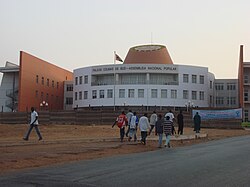| Languages of Guinea-Bissau | |
|---|---|
 Voter education posters in the Kriol language for Guinea-Bissau legislative election, 2008, Biombo Region. | |
| Official | Portuguese |
| Recognised | Badyara, Bainouk-Gunyuño, Balanta-Kentohe, Bassari, Bayot, Biafada, Bijago, Fula, Jola-Felupe, Jola-Fonyi, Kasanga, Kobiana, Mandinka, Manjak, Mankanya, Mansoanka, Nalu, Papel, Soninke |
| Vernacular | Guinea-Bissau Creole |
| Foreign | French, English |
| Signed | Guinea-Bissau Sign Language |
| Keyboard layout | |

The official language of Guinea-Bissau is Portuguese, which was spoken by 32.1% of the population according to the 2009 census. [1] It is the language of instruction in schools, the language of literary production, the written press, legislation and administration.
Contents
The local lingua franca, spoken by 90.4% according to the same census, is a creole language on a Portuguese basis which officially is called Guinea-Bissau Creole but colloquially is called Crioulo or Kiriol.
Several indigenous African languages are spoken by about half of the population, much more in rural than in urban settings.
French is taught in schools as foreign language, because Guinea-Bissau is surrounded by French-speaking countries and is a full member of the Francophonie as well as the Lusophone CPLP. [2] English is also taught but to a lesser degree than French.
